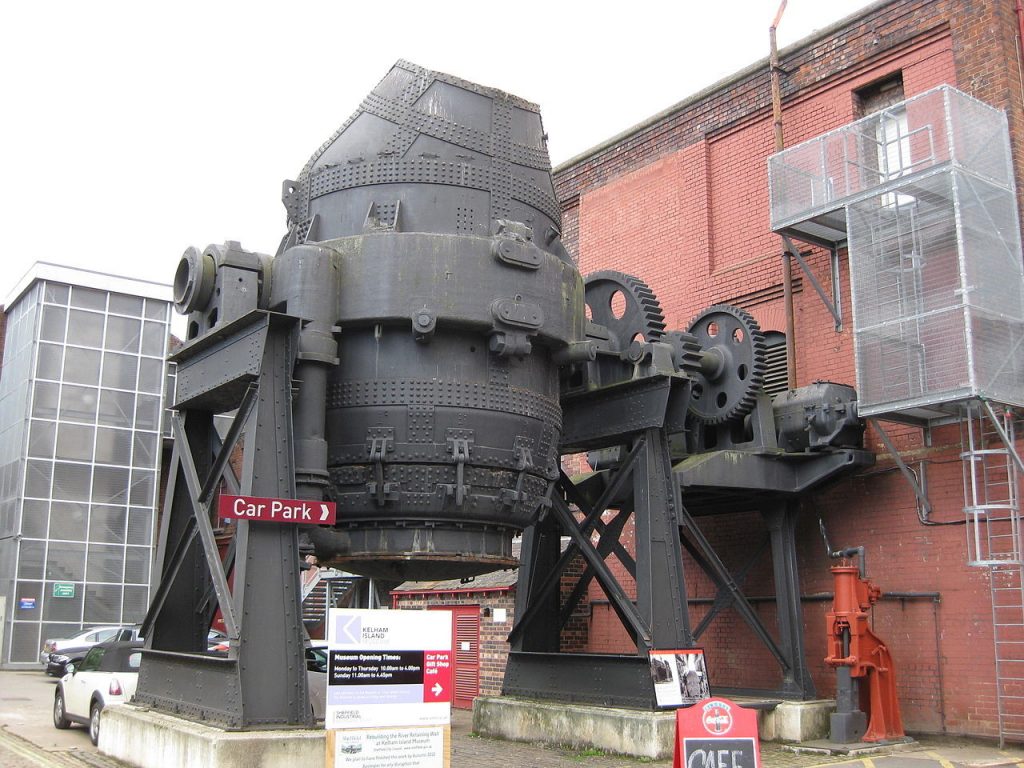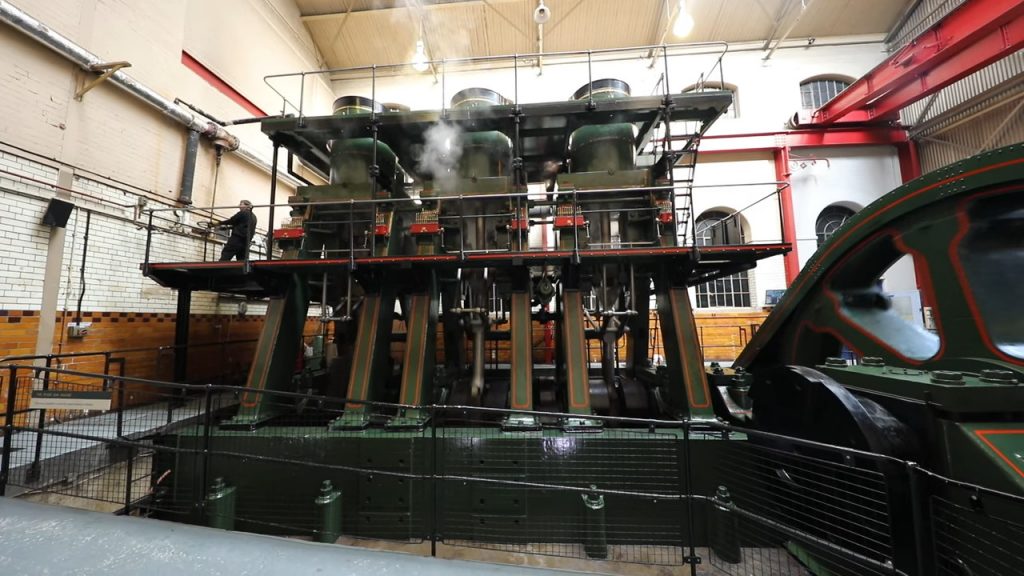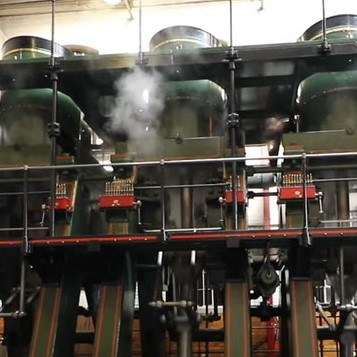In previous columns, I’ve made mention of the fact that my mother is prone to grabbing the conversational reins with gusto and abandon (and, it goes without saying, but I’ll say it anyway, aplomb). She waits for an opportunity to present itself and then leaps into action employing one of her classic opening gambits along the lines of, “Speaking of which, I met Mrs Greebles outside the fishmonger’s the other day, and she said…”
And the hours slip by as mother wanders so far out into the conversational weeds that her audience seriously starts to think about dispatching a search party. Until, suddenly and unexpectedly, she brings it all back home with a conclusion like, “And that’s why you should never name a walrus ‘Wally’!” And everybody shakes themselves as if awakening from a dream thinking, “Good grief, that’s right, we were talking about seabound mammals!” Well, sit back and watch in awe as I make my mother proud.
As you may recall, I was born and bred in the city of Sheffield in the county of Yorkshire in that paradise on Earth known to the bards as Albion. People have a certain way of speaking in the Yorkshire region of Northern England. Known as the Yorkshire dialect (also Broad Yorkshire, Tyke, Yorkie, or Yorkshire English), and represented in classic works of literature such as Wuthering Heights and Nicholas Nickleby, this is actually a continuum of dialects with roots in Old English (Anglo-Saxon) and influences from Old Norse.
Even in England, those people unfortunate enough to be born outside of Yorkshire can find it difficult to understand what’s going on without the aid of a translator. For example, as I wrote in my blog, “Ey up!” Hanging with my Peeps, the phrase “Ey up” or (“Eh up”) would be one way to say “hello” in Yorkshire.
Just to increase the fun and frivolity, Sheffield has its own flavor of this dialect, which is known as Broad Sheffield or Sheffield Tyke. You might think of this as Yorkshire Tyke on steroids. My mom was born in one of the poorest parts of Sheffield. When she was growing up, everyone in that area spoke Sheffield Tyke (many of the older inhabitants continue to converse in this dialect to this day).
In my blog, The Times They Are a-Changin’, I explained how my grandmother had lost her hearing due to meningitis when she was about 17 years old; also, that my grandfather was away in the Royal Navy “Serving King and Country” during WWII. They didn’t get electricity installed in their house until the middle of the war when my mother was about 12 or 13 years old, after which it was my mom’s job to listen to the radio and tell my grandmother (who could read lips) what was going on in the world.
While listening to the radio presenters, it dawned on my mom that she was never going to get a good job if she continued to warble in Sheffield Tyke, so she determined to teach herself to “talk posh” by practicing speaking like the BBC news announcers on the radio (think My Fair Lady with my mom playing the role of Eliza Doolittle and a gaggle of BBC news announcers taking turns as Professor Henry Higgins).
In Sheffield and other parts of South Yorkshire, the word “gennel” refers to a narrow passageway or alleyway that passes between houses or buildings (they say “ginnel” in other parts of England). Meanwhile, the term “little mester” (pronounced “mess-ter”; think “little master”) referred to a self-employed worker who rented space in a factory or worked out of his own workshop. The little mesters either worked alone or employed a small number of workers and/or apprentices.
The reason I mention this here is that, when I was a small lad about three years old, my grandmother used to take care of me during the day and then walk me from her house to my home in the afternoon. On our way, we passed through a labyrinth of gennels threading through a humongous industrial area that was jam-packed with little mesters and their workshops. I remember these magical excursions as though they were yesterday, peeking through the cracks in the thick and ancient wooden workshop doors (any windows were located high up on the walls), watching machines moving and men laboring, hearing engines straining and hammers pounding, and seeing sparks fly from grinding wheels.
I want you to keep all of the above in mind while I proceed to further set the scene. There’s an industrial museum in Sheffield called Kelham Island. In addition to awesome artifacts like England’s largest surviving Bessemer converter, which is located outside the main building, the museum itself contains all sorts of amazing things, including a recreation of a gennel lined with examples of reconstructed little mesters’ workshops.

Bessemer Converter located outside the entrance to the Kelham Island Museum (Image source: Chemical Engineer/Wikipedia)
Out of all of the museum’s wonderful exhibits, one stands proud in the crowd — the River Don Engine. As I discussed in my column, Secure Your Data at Rest, Stupid!, my mom used to work at a company called Davy-United. The “Davy” portion of this moniker came from the Davy Brothers, who set up a business in 1830 to make steam engines at Lady’s Bridge in Sheffield. In the first years of the 20th century, the Davy Brothers company built four identical steam engines. Three went to other locations, but the fourth — now known as the River Don Engine — remained in Sheffield where it was used for hot rolling steel armor plate.
Claimed to be one of the most powerful steam engines ever built, this bodacious beauty is a 3-cylinder simple engine of 40 inches (1.0 m) diameter, 48 inches (1.2 m) stroke. At its operating steam pressure of 160 psi, it developed 12,000 horsepower (8.9 MW) and was able to reverse from full speed in only two seconds. This rapid reverse capability was an essential feature of an engine used for rolling, as delays would result in the cooling of the workpiece.

The River Don Engine at Kelham Island Museum.
In 2017, I was fortunate enough to visit the Kelham Island Museum with my dear old mom to see the River Don Engine in action. Observe the small man on the gantry on the left-hand side of the picture. Also observe the monster flywheel on the right-hand side of the picture. At the beginning of each demonstration, the man commences to turn his control wheel, the three pistons start to go up and down, and the flywheel begins to spin.
Before long, the pistons are pounding furiously and the flywheel is racing rambunctiously. Then, just when you are least expecting it, the man throws a lever and the flywheel stops and reverses direction. In the paragraph preceding the picture above, I noted that the engine was able to reverse from full speed in only two seconds. Did you pause to think what that actually means (or did you just assume I’d made a mistake)? All I can tell you is that when that ginormous flywheel, which was whizzing around, stopped in its tracks and reversed direction in front of my very eyes, I’m not ashamed to admit to exclaiming “Goodness gracious me!” (or words to that effect).
Believe it or not, although this video shows the River Don Engine in all its glory, it also shows it running at only a fraction of its full speed. Even now, when I think about what I saw, I find it hard to believe that — when the man threw the reverse control — the flywheel didn’t rip loose from its moorings, exit through the museum wall, and roll down the street crushing all in its path.
As an aside, just a couple of days ago as I pen these words, I was chatting with my chum Carpenter Bob in his workshop, where I was toiling on my latest hobby project (see also The Secret to Smoking-Hot Joints). By some strange quirk of fate, I happened to mention my visit to the museum and seeing this engine perform its magic. I remember telling Bob that, if I hadn’t seen the engine reverse while running at full speed with my own eyes, I wouldn’t have believed such a thing to be possible. Also, that if someone else had told me about this, I wouldn’t have believed them. (I just sent Bob a link to the above video.) But we digress…
My mom likes to keep busy. For example, she’s a member of the Charles Dickens Society, a writing group, and a walking group, to name just three organizations that she favors with the radiance of her smile. Yes, of course this is part of the plot (do you dare doubt me?) because one of the walking group’s annual activities is to take a themed stroll around Sheffield and — as part of this — they ask the members of the writing group to pen a compendium of articles featuring places of interest. These articles are then compiled into a small booklet, which members of the walking group take turns reading aloud as they meander their way through the city.
The theme for 2017 was “Technology” so, on the basis of our earlier visit to the Kelham Island Museum, my mom determined to pen her piece on the River Don Engine. But wait, there’s more, because — just for giggles and grins — she decided to write it in Sheffield Tyke.
Good Golly Miss Molly! Do you see how I’ve managed to weave all of my seemingly stream-of-consciousness threads together? It’s almost as though I’m a man with a plan. This is similar to the way in which my mother regales her audiences with her epic tales (I dare to hope I’ve made her proud). So, without further ado, here’s my mom’s contribution to the aforementioned compendium, which is told through the metaphorical eyes of the River Don Engine (keep your own eyes open for “The American Man,” which is where the engine mistakes yours truly — my mother’s eldest son — for a son of the New World):
IT’S THAT TIME AGEN
Oh lore, he’s getting up them steps agen. What day is it? Ah feel reight rested so it must be Sunday. That means ah’ve got to perform for the public three times today. Still, it takes him some time to get everything ready, so ah’ll pass this time thinking of my younger days when ah were really somat for Sheffield to be proud of.
Ah now perform three times on Sunday, but this were t’day of rest when ah were a nipper — not in t’War years though. And now, Sundays is just the same as all t’others.
Now on Sundays ah have to wake mesen up and perform for ten minutes at 12.00 noon, 2.00 pm and 4.00 pm and often t’watchers are not impressed. Ah suppose if he were a little green man wi big ears, they’d tek more interest, but he’s only an old steel worker. At least he shows he loves me. When ah think o’ when ah were born — that were a very different matter, that were.
Tha’s not seen many babies weigh in at 420 tons. Ah did. Ah were 28 ft high and 40 ft long (ah don’t have nowt to do wi them metric measures tha as nowadays).
When tha thinks abaht it, ah were a miracle in 1905 when them wonderful engineers at Davy Brothers made me in their Park Iron Works at Norfolk Bridge darn Attercliffee. Tha’s got to remember that them lads didn’t ave them Tablets and iPads and things like they’ve got these days. They ‘ad to do everything in their ‘eads and woe betide them if they med a mistake. Old Alfred Davy wud be on them like a ton o’ bricks.
Ay, when ah cum together all reight, it were a great day for Davy Brothers. Ah were made to drive Charles Cammell’s armour plate rolling mill at their Grimesthorpe Works. That were a big devil ah can tell thee, but ah did it reight well. Wi 420 tons and 12,000 horsepower, ah could drive them rollers to roll steel plate up to 16 inches thick (they’ll tell thee it were 40 centimetres but ah don’t have owt to do wi them things), and up to 50 tons in weight. Cammells supplied tough armour-plated steel to the ship-building industry, so ah were most important in both them World Wars.
Ah worked for them for 50 years and then were sold to t’British Steel, River Don Works, where ah continued to drive a heavy plate mill supplying shields and steel plate for the North Sea Oil Rigs.
It caused such excitement when ah were born that ah got three brothers. One were bought by John Browns for their Attercliffe Works, one were sold to t’Japanese Government and ah’ve no idea what ‘appended to t’other one.
When ah first started work, ah did one or two shifts a day, but as we needed more heavily armoured ships ah had to do three shifts a day, sometimes seven days a week. Wud tha’ be able to do that? No, nor did them as worked wi me. Well, tha can’t expect a human to work twenty-four hours a day, and ah must admit they did respect me. It were a special job to see that ah were kept going and they worked very hard to make that possible.
And then, in 1978, ah were put aht to grass. What a cum down. But tha sees, t’Government ‘ad nationalised t’Steel Industry and all them fine steel works started to be shut dawn. The newer and better mills were sold off, but ah were considered to be obsolete. Me? Obsolete? ‘Course ah weren’t — ah were just a bit old and quite small compared wi the newer mills.
Well, that were a sorry time ah can tell thee and ah were left to rot on a railway siding outside in all weathers. And then they took over Kelham Island Works but t’youing man who owned it ‘adn’t any idea of running a business and he sold it to t’Council as a museum. And ah were picked up — not literally tha knows — but someone had the nouse to realise that ah were worth preservin.
So now, Monday to Thursday, ah’m ‘waked at 12.00 and 2.00pm, switched on and made to perform to a small audience who sometimes couldn’t care less. And on Sundays ah do it three times. They think that’s all reight since ah’ve ‘ad two days’ rest, but ah know ah’m beginning to feel my age. My man is very caring and really looks after me, but ah heard ‘em say that my ageing equipment and their limited resources means that they can’t guarantee that ah can carry on.
That’s a shame because only t’other day ah heard ‘im telling a man from America that ah still run on steam and ah’m the most powerful working steam engine in Europe today — just as ah were when ah were born.
Tha knows, when ah were built, Davy’s ‘ad 800 to 1,000 men working for them and they grew and grew until they nationalised t’ Steel industry. Ah were sorry to hear they’re quite a small company now. But they’re lucky that they’re still there. A lot of the Steel Companies are closed down with all their finest workers on the dole and even here in Sheffield, the steel works is owned by Tata Steel of Jamshedpur – and they’re always talking about redundancies.
Ey up — he’s got t’steam up and he’s sorting t’gears out. Gird up thi loins old man, tha’s got to go up, stop dead and cum back; then go up again, stop dead and cum back; and do this for ten minutes. Then he’ll leave me for an hour and it’s performing agen.
Oh, there’s that American man agen. He were quite fascinated at my precision yesterday and he’s cum back. Ah can see that he’s really interested in me and the way in which ah work. Ah suppose ah’ll be sad if they have to put me down, but ah can always live in ‘ope.
For your further delectation and delight, I managed to persuade my little ‘bro Andrew to take this video of mom reading this story aloud.
I should perhaps note that mom turned the Sheffield Tyke dialect dial down drastically so as to give everyone at least a batting chance of following along. I would love to hear what you think about all of this and, as always, I appreciate your comments and questions.





